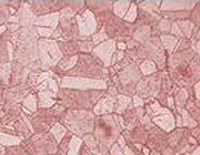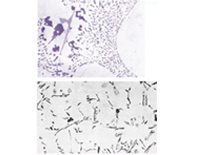Carbonitriding Services
Gas Carbonitriding Liquid :

- Gas carbonitriding is similar to carburizing, except that small additions of nitrogen are added to the atmosphere and the temperature is slightly lower. Consequently, the case depth and therefore, the load carrying capability is not as high as with carburizing, but the wear resistance and dimensional control are often superior.
- Carbonitriding has the further advantage that it can be performed on unalloyed steels, so that it can be used for small stampings or other types of machined parts to make a strong, wear resistant part economically.
- Size - 1500 Ø X 2800 mm Length
Liquid Carbonitriding :

- Liquid carbonitriding is the process of diffusion enrichment of the surface layer of a part with carbon and nitrogen provided by a molten salt.The process is carried out at the temperatures 820-860°C Carbonitriding is used primarily to impart a hard, wear-resistant case, generally from 0.075 to 0.75 mm deep. A carbonitrided case has better hardenability than a carburized case (nitrogen increases the hardenability of steel; it is also an austenite stabilizer, and high nitrogen levels can result in retained austenite, particularly in alloy steels).
- Consequently, by carbonitriding and quenching, a hardened case can be produced at less expense within the case-depth range indicated, using either carbon or low-alloy steel. Full hardness with less distortion can be achieved with oil quenching, or, in some instances, even gas quenching, employing a protective atmosphere as the quenching medium.
Benefits of heat treatment in salt baths:
- Fast heating. A work part immersed into a molten salt is heated by heat transferred by conduction (combined with convection) through the liquid media (salt bath). The heat transfer rate in a liquid media is much greater than that in other heating mechanisms: radiation, convection through a gas (e.g, air).
- Heat Treatment of Metals Like Hardening, Austempering, Carburising, Gas Nitriding, Liquid Nitriding, Oxidising, Steaming, Hardening, Tempering, Stress Relieving, Annealing, Normalising, Precipitation Hardening, Induction Hardening, Nitro carburising, Carbonitriding.
- Controlled cooling conditions during quenching. In conventional quenching operation either water or oil are used as the quenching media. High cooling rate provided by water/oil may cause cracks and distortions. Cooling in molten salt is slower and stops at lower temperature.
- Low surface oxidation and decarburization. The contact of the hot work part with the atmosphere is minimized when the part is treated in the salt bath.
Size - 1500 ØX 2800 mm Length
Copper Heat Treatment Services :


- We are a coveted organization that is engaged in offering Copper Heat Treatment Services to customers.
- Our professionals work in close proximity with customers to render these services as per their choices and preferences.
- Furthermore, our quality controllers stringently check the entire treatment process on different parameters to ensure about flawlessness.
- Size- 1000 Ø X 3000 mm Length
Aluminum Heat Treatment Services :

- We are engaged in undertaking Aluminum Heat Treatment Services for our clients. Heat Treatment of aluminum alloys, employed to increase strength and hardness of the precipitation-hardenable wrought and cast alloys by Solutionising and Precipitation Hardening.
- These usually are referred to as the "heat-treatable" alloys to distinguish them from those alloys in which no significant strengthening can be achieved by heating and cooling.
- The latter, generally referred to as "non-heat-treatable" alloys, depend primarily on cold work to increase strength.
- Heating to decrease strength and increase ductility (annealing) is used with alloys of both types; metallurgical reactions may vary with type of alloy and with degree of softening desired.
- Except for the low-temperature stabilization treatment. We use technologically advanced furnaces while executing this job work.
- Size - 1000 Ø X 3000 mm Length
Hardening and Tempering :


- Martensitic or quench hardening, neutral hardening is a heat treatment used to achieve high hardness / strength on steel.
- It consists of austenitising, quenching and tempering, in order to retain a tempered martensite or bainite structure.
- steel can be treated by intense heat to give it different properties of hardness and softness.
- This depends on the amount of carbon in the steel (only high carbon steel can be hardened and tempered).
- Tempering is a low temperature (150°C to 650°C) heat treatment intended to remove the stresses and brittleness caused by quenching and to develop the required mechanical properties.
GAS HARDENING & TEMPERING (800 Ø X 2000 mm Length)
LIQUID HARDENING & TEMPERING (1500 Ø X 3000 mm Length)
Gas Carburising (Surface Hardening) :


- Gas Carburising Process is a surface hardening process, which improves the case depth hardness of a component by diffusing carbon into the surface layer to improve wear and fatigue resistance.
- The work pieces are pre-heated and then held for a period of time at an elevated temperature in the austenitic region of the specific alloy, typically between 820 and 940°C. During the thermal cycle the components are subject to an enriched carbon atmosphere such that nascent species of carbon can diffuse into the surface layers of the component.
- Size- 1000 Ø X 3000 mm Length
Liquid Carburising Service :
- Liquid Carburizing is essentially the addition of carbon at the surface of low carbon steels at appropriate temperatures.
- Case hardening is achieved with the quenching of the high carbon surface layer that has a good fatigue and wear resistance.
- This layer is applied on a tough low carbon steel nucleus.
- Case hardening of the carburized steels is mainly a function of carbon content.
- When steel carbon contents exceed a certain percentage, hardness is not affected by further carbon addition.
- Additional carbon at this stage is not dissolved.
- Steel case hardening depth of the carburized steel depends upon the carburizing time and the surface carbon intensity.
- When the carburizing time is prolonged to obtain increased case depths, excessive free carbides may be formed.
- The micro-structural elements have an unfavorable effect on the distribution of residual stresses.
- Carburized steels generally have base carbon contents of pproximately 0.2% while the carburized layer has carbon contents in the range of 0.8% and 1%.
- Most carburized steels are deoxidized by the addition of aluminum.
- Due to the carbon content difference in the core and the case, their case hardening capability is also different.
- Size - 3.0 mm C.D (1500 Ø X 2800 mm Length)
If you have any query related our products ... We are available



